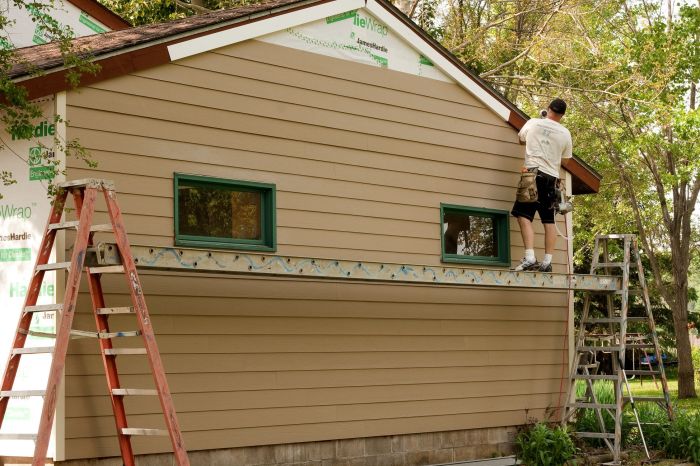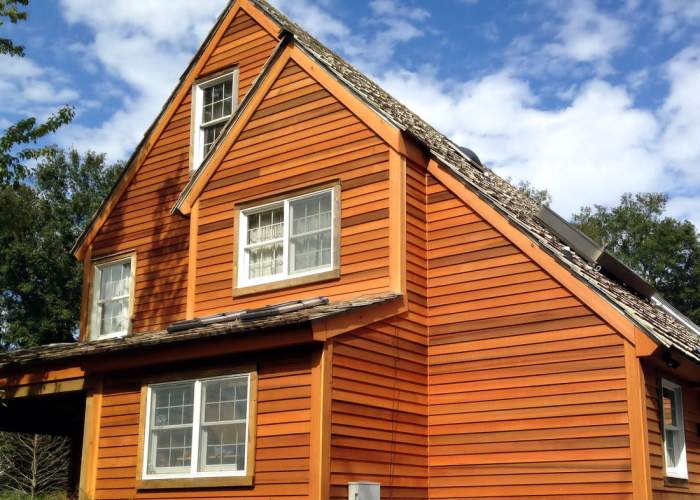Mastering Painting and Siding: A Comprehensive Guide
Painting and siding go hand in hand, playing crucial roles in enhancing the aesthetics and durability of a property. From exploring various painting techniques to delving into the world of siding materials, this guide is your go-to resource for all things related to painting and siding.
Whether you're a seasoned DIY enthusiast or a homeowner looking to spruce up your property, this guide will equip you with the knowledge and tips needed to tackle your next painting and siding project with confidence.
Painting Techniques

When it comes to painting siding, there are various techniques that can be used to achieve a professional-looking finish. From preparation to application, each step plays a crucial role in the final result.
Preparing Siding for Painting
Before starting the painting process, it is essential to prepare the siding properly. This involves cleaning the surface to remove any dirt, mildew, or loose paint. Additionally, any cracks or holes should be filled, and the surface should be sanded to create a smooth base for painting.
Types of Paint Finishes
- Flat Finish: Provides a smooth and subtle appearance, ideal for hiding imperfections on siding.
- Satin Finish: Offers a slightly glossy look that is easy to clean, making it a popular choice for siding.
- Semi-Gloss Finish: Provides a durable and shiny finish, suitable for high-traffic areas like siding.
Tips for Professional-Looking Paint Job
- Use high-quality paint and tools to ensure a smooth and even application.
- Apply primer before painting to improve adhesion and longevity of the paint.
- Work in small sections to avoid drying lines and overlap wet edges to maintain a consistent finish.
- Consider the weather conditions when painting siding, as extreme temperatures or humidity can affect the paint's performance.
Siding Materials
When it comes to choosing siding materials for your home, there are several options available, each with its own set of pros and cons. It's essential to consider factors such as paint adhesion, longevity, and maintenance requirements when selecting the right siding material for your property.
Vinyl Siding
Vinyl siding is a popular choice for homeowners due to its affordability and low maintenance requirements. However, when it comes to painting, vinyl siding can be challenging as the paint may not adhere well to the surface. Additionally, vinyl siding may not be as durable as other materials, leading to potential issues with longevity.
Fiber Cement Siding
Fiber cement siding is known for its durability and resistance to various weather conditions. When it comes to paint adhesion, fiber cement siding provides a stable surface for paint application, resulting in a long-lasting finish. While fiber cement siding requires less maintenance compared to wood siding, it may be more expensive upfront.
Wood Siding
Wood siding offers a classic and natural look to homes, but it requires regular maintenance to prevent rot, mold, and insect damage. Paint adhesion on wood siding is generally good, but the longevity of the paint finish may vary depending on the wood species and the quality of the paint used.
Keep in mind that wood siding may be more costly to maintain over time.
Comparative Table of Siding Materials
| Siding Material | Cost | Durability | Maintenance |
|---|---|---|---|
| Vinyl Siding | Affordable | Less Durable | Low Maintenance |
| Fiber Cement Siding | Moderate | Durable | Moderate Maintenance |
| Wood Siding | Expensive | Varies | High Maintenance |
Color Selection
When it comes to choosing paint colors for siding, there are several factors to consider in order to enhance the overall aesthetic of a property. From the architectural style of the building to the surrounding environment, the right color can make a significant impact on the curb appeal of a home.
Factors to Consider
- Architectural Style: Different architectural styles lend themselves to specific color palettes. For example, a Victorian-style home may look stunning in pastel colors, while a modern home might benefit from bold, primary colors.
- Neighborhood Aesthetics: Consider the colors of neighboring homes and buildings to ensure your choice complements the overall look of the neighborhood.
- Climate and Lighting: Take into account the climate of your region and how natural light affects colors throughout the day. Lighter colors can help keep a home cooler in warmer climates.
Tips for Selecting Colors
- Test Colors: Before committing to a color, test out a few samples on the actual siding to see how they look in different lighting conditions.
- Consider Trim and Accents: Think about how the siding color will interact with the trim and other exterior accents to create a cohesive look.
- Stay Neutral or Go Bold: Neutral colors like grays and beiges are timeless and versatile, while bold colors can add personality and make a statement.
Popular Color Trends
- Earthy Tones: Shades of green, brown, and terracotta are popular choices for a natural and welcoming look.
- Dark Hues: Deep blues, charcoal grays, and black are trending for a modern and sophisticated appearance.
- Light and Airy: Soft whites, pale blues, and light grays create a fresh and airy feel, perfect for beach or coastal homes.
Color Combinations for Architectural Styles
| Architectural Style | Ideal Color Combinations |
|---|---|
| Craftsman | Earthy tones like olive green with cream accents |
| Colonial | Traditional white with black shutters for a classic look |
| Mid-Century Modern | Bold colors like mustard yellow paired with slate gray |
Weather Considerations

In the process of painting siding, weather conditions play a crucial role in ensuring the longevity and durability of the paint job. Improper weather conditions can lead to premature wear and damage, affecting the overall appearance and protection of the siding.Excessive heat or cold can have adverse effects on the painting process and the final outcome.
Extreme temperatures can cause the paint to dry too quickly or too slowly, leading to issues such as cracking, bubbling, or poor adhesion. It is essential to consider the temperature range suitable for painting and follow the manufacturer's recommendations for the specific paint product being used.
Painting in Extreme Temperatures
When painting siding in extreme temperatures, it is important to plan the project carefully and take necessary precautions to ensure the best results. Here are some recommendations to follow:
- Avoid painting in direct sunlight or extreme heat, as this can cause the paint to dry too quickly and lead to uneven application.
- Paint during the cooler parts of the day, such as early morning or late afternoon, to achieve better results.
- Consider using paint additives or products designed for use in extreme temperatures to improve the finish and durability of the paint job.
Importance of Proper Weatherproofing
Proper weatherproofing is essential to protect painted siding from the elements and prevent damage over time. Weatherproofing helps to seal the paint, creating a barrier against moisture, UV rays, and other environmental factors that can cause deterioration. It is important to use high-quality weatherproofing products and follow the manufacturer's instructions for application.
Preventing Weather-Related Damage
To prevent weather-related damage to painted siding, consider the following tips:
- Regularly inspect the siding for signs of wear, peeling, or cracking, and address any issues promptly.
- Keep the siding clean and free of debris to prevent moisture buildup and mold growth.
- Apply a fresh coat of paint or weatherproofing treatment as needed to maintain the integrity of the siding.
Concluding Remarks
In conclusion, mastering the art of painting and siding is not just about adding a fresh coat of paint or installing new siding. It's about understanding the intricacies of each process, making informed decisions, and transforming your property into a true masterpiece.
Armed with the insights from this guide, you're ready to embark on your painting and siding journey with skill and finesse.
Q&A
What are some common painting techniques used for siding?
Common painting techniques for siding include brushing, rolling, and spraying. Each technique offers its own set of advantages and is suitable for different types of siding materials.
How do I choose the right paint color for my siding?
When selecting a paint color for your siding, consider factors such as the property's architectural style, surrounding landscape, and personal preferences. It's also helpful to test paint samples on a small area to see how they look in different lighting conditions.
What maintenance requirements are associated with different siding materials?
Vinyl siding typically requires periodic cleaning with a mild detergent, while wood siding may need regular painting or staining to maintain its appearance. Fiber cement siding is known for its durability and low maintenance needs.
How can extreme weather conditions affect painted siding?
Extreme weather conditions such as intense heat or cold can cause painted siding to expand or contract, leading to cracking or peeling. It's important to choose high-quality paint and properly prepare the siding surface to withstand such conditions.




